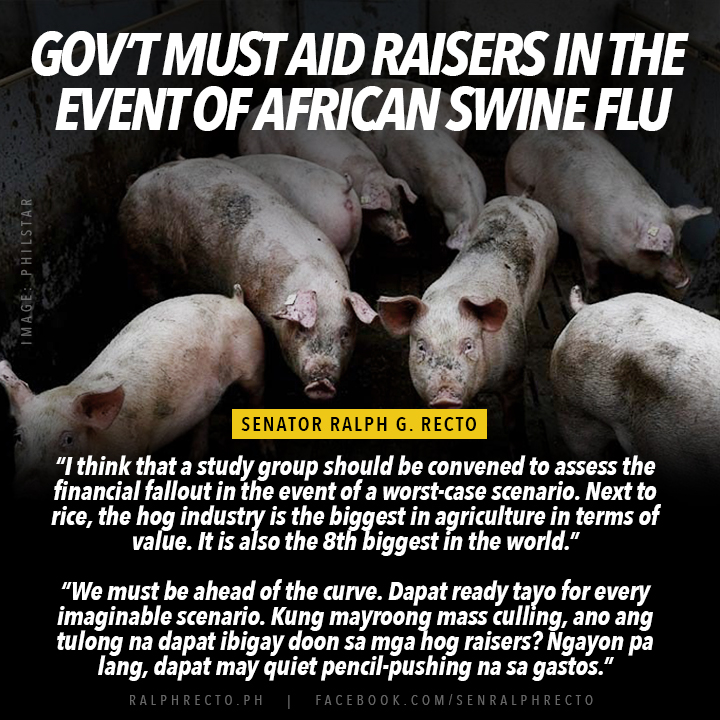PH hog industry is 8th biggest globally; gov’t must aid raisers in the event of ASF
Government should open up a new front in contingency preparations for African Swine Flu, on how to financially help people in the P280 billion a year industry if tests prove that the deadly disease is already here.
“I think that a study group should be convened to assess the financial fallout in the event of a worst-case scenario. Next to rice, the hog industry is the biggest in agriculture in terms of value. It is also the 8th biggest in the world,” Senate President Pro Tempore Ralph Recto said.

While Department of Agriculture (DA) and Department of Health protocols to contain the diseases “are in place and have been rehearsed, how to mitigate the financial disaster is, I think, an unexplored area,” Recto said.
“We must be ahead of the curve. Dapat ready tayo for every imaginable scenario. Kung mayroong mass culling, ano ang tulong na dapat ibigay doon sa mga hog raisers? Ngayon pa lang, dapat may quiet pencil-pushing na sa gastos,” Recto said.
Doing such a thing is not to be alarmist, but simply to be prepared, Recto said.
He said readying an assistance package for hundreds of thousands dependent on the local hog industry “is beyond the mandate” of the DA.
“Of all the powers of the DA secretary, the power to appropriate or to release allotments is not one of them,” he said.
“It is something that is discussed in the highest levels of government, in the Cabinet, in both houses of Congress, more so if it requires a huge amount of money and bridge financing,” Recto said.
Recto said the hog industry is a pillar of Philippine economy, with millions earning a living on the swine supply chain.
With annual production nearing 2.3 metric tons, it is the 8th biggest in the world by volume, Recto said.
Any production disruption will be felt on Filipino dining tables, Recto said. “Remember, this is the land of lechon, the national fiesta food; adobo, the national comfort food; sisig, is one of the pambasang pulutans; and longganisa and tocino are the breakfast of champions.”
Four years ago, Filipino families were already buying P101 billion worth of fresh pork alone.
“Kung decreasing ang fish catch natin, at mahal na rin ang maraming isdang dagat, tapos mawawala pa ang pork—kailangan talaga may turnaround plan na nakahanda para sa industriya, para makabangon kaagad sila,” Recto said.
Kung magiging disaster ito, the hog industry deserves calamity aid, he said.
Recto said the government collected duties and taxes on imported pork product, which in 2018, reached 312,499 metric tons valued at almost P25 billion.

